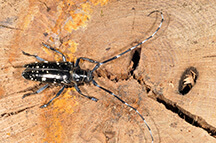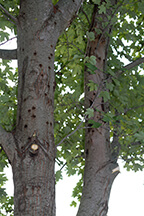Effort on to stop spread of Asian longhorned beetle
August 24, 2015
 |
|
The adult Asian longhorned beetle is easily recognized by its long antenna, white spots and white bands on its wings. (Purdue Entomology photo/Jon Obermeyer) |
WEST LAFAYETTE, Ind. - A Purdue University entomologist is urging people to check trees for signs of the invasive Asian longhorned beetle during the month of August, a time of peak emergence of the beetle, and report any sightings.
Cliff Sadof noted that the U.S. Department of Agriculture's Animal and Plant Health Inspection Service, or APHIS, is in the midst of a campaign to raise public awareness of the beetle, which threatens urban and suburban shade trees, recreational resources such as parks, forest resources and wildlife.
"If you see an Asian longhorned beetle you should to report it," he said. "It is highly destructive. Once a tree is infested there is no cure for it."
Sadof noted that the beetle can be reported by calling 1-866-NO-EXOTIC. Alternatively, reports could be made through smartphone apps or websites listed on the Indiana Invasive Species Council website http://www.entm.purdue.edu/IISC/. From there, reports go to the state and then to Purdue for confirmation.
In addition to seeing it on trees, Sadof said the beetle often lands in swimming pools.
"For those who have a swimming pool, they should check their water skimmers for beetles," he said.
 |
|
Dark scars left by Asian longhorned beetles that laid eggs on the trunk of a red maple tree. (Purdue Entomology photo/Cliff Sadof) |
The beetle and common pests of trees can also be identified with the Tree Doctor app available at Purdue Extension's The Education Store at www.edustore.purdue.edu.
The Asian longhorned beetle is a distinctive-looking insect with these characteristics:
* Body is about 1 inch to an inch and a half in length.
* Antennae, longer than the insect's body, banded in black and white.
* Shiny jet-black body with random white spots.
* Six legs and may have bluish-colored feet.
APHIS said signs of an infestation start to show about 3-4 years after the tree is infested. Such trees show these signs:
* Dime-sized or smaller round exit holes in the tree trunk or branches.
* Shallow oval or round scars in the bark, where the adult beetle has chewed an egg site.
* Sawdustlike materials, called frass, on the ground around the tree or on the branches.
* Dead branches or limbs falling from an otherwise healthy-looking tree.
APHIS said the beetle has led to the loss over 130,000 trees in the United States since it was discovered in 1996. The insect has no known natural predators in the U.S. It bores through the tissues that carry water and nutrients throughout the tree, starving and weakening the tree until it dies. Early detection is important in stopping the spread of the beetle because an infested tree must be removed.
Writer: Keith Robinson, 765-494-2722, robins89@purdue.edu
Source: Cliff Sadof, 765-494-5983, csadof@purdue.edu
Ag Communications: (765) 494-2722;
Keith Robinson, robins89@purdue.edu
Agriculture News Page

